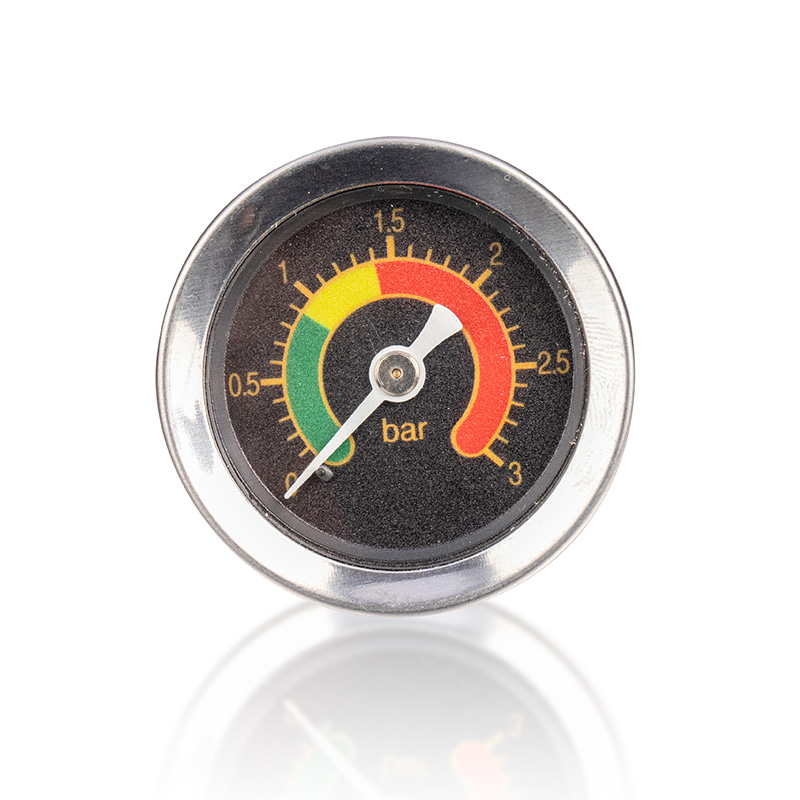+86-15105800222
+86-15105800333
Need help? Call us: +86-15105800333 / Whatsapp:+86-15105800333 / Email:[email protected]
- Home
- Product
- About
- Strength
- News
- Contact
As a composite system integrating thermodynamics, hydraulic dynamics and precision mechanical control, the running stability of the coffee machine is directly related to the quality and flavor consistency of coffee extraction. As an important instrument for judging the working status of the coffee machine and regulating the pump pressure and boiler pressure, the accuracy of the pressure gauge depends on the tightness of the entire system. Especially under high-pressure extraction conditions, the sealing performance of the pressure gauge body and its connection parts is crucial. Once the seal fails, it will not only cause reading errors, but also may cause a series of chain problems.
Reading errors increase, affecting parameter judgment
The most direct consequence of pressure gauge seal failure is distorted pressure readings. Once the seal is aged, damaged or improperly installed, a small amount of leakage will occur between the connecting pipe and the pressure gauge body. This kind of pressure relief cannot constitute a water jet, but it is enough to reduce the actual pressure transmitted to the inside of the pressure gauge. Therefore, the needle cannot stay stably at the set pressure value, which is manifested as continuous tremor, zero return delay or pointer jitter, thereby misleading the operator to make an incorrect pressure adjustment judgment. For example, the normal working pressure of 8.5 bar may only be displayed as 6 bar under the pressure relief effect, which may lead the user to mistakenly increase the pump pressure or refill the powder cake, resulting in over-extraction.
Unstable extraction quality and flavor deviation
The coffee extraction process is highly dependent on pressure, and the stability of pressure directly affects the extraction time, liquid concentration, oil formation and dissolution ratio. When the coffee machine pressure gauge fails to provide accurate feedback due to seal failure, the machine may continue to operate in a non-ideal pressure range without knowing it, ultimately affecting the consistency of the quality of each cup of coffee. Especially in commercial coffee scenarios, continuous micro-pressure relief will cause the machine to gradually deviate from the original setting during daily high-frequency operation, resulting in insufficient extraction in the front section, increased impurities in the back section, and uncontrollable fluctuations in the flavor curve, which is not conducive to the barista's stable control of the product style.
The boiler control logic is disturbed and the heat and pressure are not coordinated
Some mid-to-high-end coffee machines use a control system based on pressure sensing, and their boiler temperature control logic is based on real-time pressure feedback. Seal failure will interfere with the normal operation of this closed-loop control system and cause the boiler to misjudge the current pressure state. For example, in a heat exchange structure, if the pressure gauge has a false low reading, the temperature control system may continue to heat and cause the boiler to overpressure, thereby triggering the safety valve to force discharge or the main control board to limit power protection, reducing the efficiency of the whole machine, and even causing thermal shock to the heating element. On the contrary, if the reading is high, the machine may stop heating, causing the brewing water temperature to drop, resulting in insufficient extraction temperature.

Increased safety risks, causing water seepage or failure
In severe cases, seal failure may cause high-pressure hot water or steam to seep out from the joints of the gauge body, which not only endangers the safety of the operator, but also may affect the insulation of adjacent electronic components. Especially in designs with control circuits, relays or PCB motherboards under the pressure gauge, once water vapor penetrates, it will cause short circuits, corrosion, signal interference and other hidden dangers. In addition, if the coffee machine pressure gauge body is a glass mask structure, long-term use in a poorly sealed, pressurized and vibrated state may cause the shell to crack or burst, and there is a risk of splashing in a high temperature and high pressure environment. Equipment manufacturers need to fully consider the installation angle, sealing method and force path of the pressure gauge assembly.
Increase equipment maintenance frequency and use cost
Once the seal failure affects the normal operation of the pressure gauge, it will force the equipment to enter the maintenance cycle ahead of time. The pressure gauge and its connecting components are usually non-disposable wearing parts, and their removal, replacement and resealing require high labor costs. In some compact commercial coffee machines, because the pressure gauge is buried inside the machine body, the replacement operation may involve large-scale disassembly of the machine, affecting daily operations. In addition, if the sealing problem is not identified in time, the operator may mistakenly judge it as a more complex problem such as pump damage or solenoid valve blockage, which will cause unnecessary misrepairs and misreplacements, resulting in economic losses.